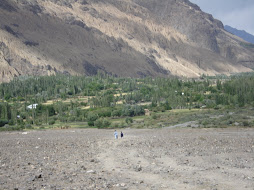ISLAMABAD: Nadir Shah, 35, from the Chitral mountain valley in northern Pakistan, about 390km northwest of Islamabad, is uncertain what to do.
Fingering the battered pay-phone card he keeps in his wallet - enabling him to call his family about once a week - Shah, who works as a domestic help, explains: "I have heard there have been flash floods. A bridge was washed away. I am wondering if I need to go back and make sure my family is safe."
According to reports, Sore Rech village, some 160km north of Chitral, the valley's main town, was cut off from the rest of the district for three days in mid-June as a suspension bridge over the River Torkhow was washed away by floods.
Nadir's family was not among those affected, but he fears further flash floods, common in mountain areas when hill torrents are triggered by heavy rain.
More severe monsoon?
Weather forecasts have been warning of a more severe monsoon this year. Uncharacteristically for mid-June, rain has already begun to fall in northern parts of the country.
"The monsoon rains this year are likely to be 25-30 percent heavier than normal in northern areas," Hazrat Mir, chief meteorologist at the Met Office in Lahore, told IRIN. He warned that major rivers could flood and that there could be flash floods in smaller waterways, which often cause the worst damage.
The monsoon rains normally cause transport problems, with water-logged roads and unstable bridges. This is especially true in northern areas, where communities are dependent on supplies sent in by truck.
Monsoon rains normally cause transport problems, with water-logged roads and unstable bridges
Food
Swelling rivers mean narrow, but vital, suspension bridges can become unsafe, and the early monsoon this year has reduced the time in which to stock up on food.
"The monsoon creates problems in bringing up essentials like 'atta' [flour] to areas such as Chitral. When there are shortages, prices soar. Everything is already more expensive than last year and I fear food prices may rise further," said Nadir Shah.
Food price inflation has been running at 15-20 percent over the past year in northern Pakistan.
"If this continues, we are in for a very tough time," says Aslam Baba, about 75, who has lived his entire life in Shahdra, a suburb on the outskirts of Lahore, capital of the Punjab. The poor locality, where many houses are made from unbaked bricks and are thus vulnerable to damage by rain or storms, lies alongside the River Ravi. Flooding is a regular feature during the monsoon which most often arrives in mid-July, with families frequently displaced and homes damaged.
"Last year was not that bad, but I can remember years when cattle were washed away and houses came tumbling down," said Aslam.
In Balochistan, the situation of cyclone survivors is grim, with many still living in temporary shelters and drinking contaminated water
Flood warnings
Things have now improved somewhat. There are better flood warning and disease prevention systems in place. "We have an elaborate system of radars and sensors to collect weather data," the Met Office’s Mir said. However, disaster control systems, which depend on government action, on the whole, remain inadequate.
There was an example of this in Thatta District, Sindh Province, about 100km east of Karachi, last week. Tidal waves, apparently triggered by monsoon weather, inundated 40 coastal villages. Local people complain no early warnings were given and they had no time to secure belongings or take other action.
Cyclone aftermath
People who live along the Sindh coastal belt have good reason to be concerned. In June 2007 Thatta was among the areas hit by Cyclone Yemyin, which affected 2.5 million people and left 350,000 displaced.
Many of the victims are still struggling to rebuild their lives. "I lost my fishing boat at sea and my home was damaged. I have struggled to rebuild it but have received very little help," said Ghulam Din, 30, from a village near Thatta.
In Balochistan, the situation of cyclone survivors is grimmer. In areas such as Jhal Magsi, 170km southwest of the provincial capital, Quetta, about 140,000 were displaced after the cyclone. Although no official estimates are available, Farid Khan, provincial coordinator for the Human Rights Commission of Pakistan, said: "Thousands still do not have proper houses while water supplies have also been contaminated by the flooding that followed the cyclone." --IRIN
Wednesday, June 18, 2008
Subscribe to:
Post Comments (Atom)
Awesome and rugged

Beauty of Chitral

Kishmanja, a beautiful village in Yarkhun valley
Lush green

DIZG: threatened by floods

The legendary village of Ayun in Chitral

On way to Bumburet
Dizg, Yarkhun

About Me

- Zar Alam Khan Razakhel
- Village Dizg, Yarkhun valley, Chitral, Pakistan
- I blog at http://chitraltoday.net (ChitralToday) about Chitral, its people, culture, traditions and issues. I have been writing about Chitral since 2000. Chitral is a scenic valley in the extreme north-west of Pakistan.
No comments:
Post a Comment